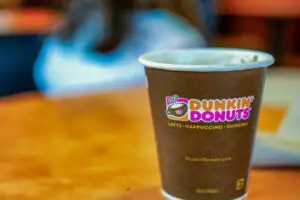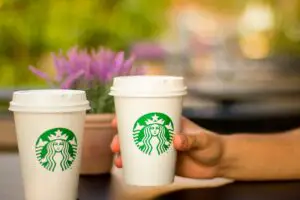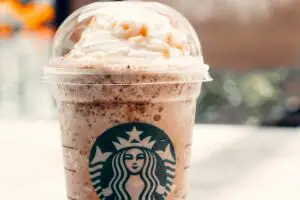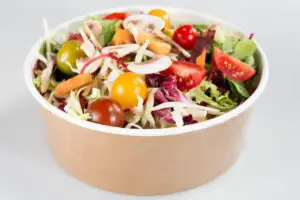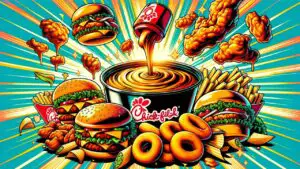*This post may contain affiliate links. As an Amazon Associate we earn from qualifying purchases.
Ah, Starbucks, the savior of every sleep-deprived parent, the muse of every budding novelist, and the financial black hole for every teenager with a frappuccino addiction.
Ever find yourself standing in line at your local Starbucks, clutching your wallet, shivering with caffeine-deprived anticipation, while the person ahead of you orders a venti half-caf skinny mocha with two pumps of vanilla, three pumps of caramel, extra foam, no whip, and precisely 137.5 degrees Fahrenheit? And you, oh simple soul, just want a regular, no-nonsense cup of joe.
So, you scream into the void – or, more accurately, mumble to the barista – “Why doesn’t Starbucks have an express line for simple orders?” I mean that seems like it would be a good idea right?
Grocery stores have had express lanes for years so why doesn’t Starbucks offer express lines for us simple folks?
The main reason that Starbucks doesn’t have an express line is because of the difficulty in describing what is “simple coffee“. Would they only allow you to order black coffee there? Could you add in cream and sugar?
Could you still order in the express line even if you also want some food? Also who decides what a simple coffee is anyway?
Starbucks doesn’t want to have their baristas deal with all of these headaches (or have a Karen yelling at them because “My coffee is too simple to make!”) so they just keep it regular lines that everyone orders at no matter how simple or complex their order is.
In the rest of this article, I will take a deep dive into the frothy world of Starbucks, where the coffee is strong, and the orders are… well, complicated.
Key Takeaways
Let’s highlight the crux of our discussion in the following points:
- Personalization Over Speed: Starbucks values the personal touch in its service. Regardless of the complexity of the order, each customer is given equal attention.
- Challenges with an Express Line: Implementing an express line at Starbucks could lead to a number of logistical and operational challenges, including disrupting the workflow, confusing customers, and requiring additional resources.
- Potential Two-Tier System: An express line could create a two-tier system, contradicting Starbucks’ ethos of treating all customers equally.
- The Starbucks Mobile App: The Starbucks mobile app acts as a digital express line, allowing customers to order, pay, and pick up their orders ahead of time, thus balancing convenience and the in-store Starbucks experience.
- Alternatives to Speed Up Service: Some potential alternatives that could speed up service without compromising the Starbucks experience include:
- Improving barista training and workflow
- Encouraging more use of the mobile app
- Implementing self-service machines for simple orders
Understanding Starbucks’ Customer Service Philosophy
Starbucks isn’t just a coffee shop. It’s a lifestyle. A lifestyle of personalized service, attention to detail, and the freedom to customize your drink until it’s unrecognizable as a coffee.
But what if you’re more of a milk-and-two-sugars kind of person? Does Starbucks’ commitment to personalized service mean you’re doomed to wait behind the soy-latte-extra-foam crowd forever?
Starbucks’ Commitment to Personalized Service
To understand why Starbucks doesn’t have an express line, we first need to understand its customer service philosophy. Starbucks prides itself on creating a “third place” between work and home.
It’s a place where baristas know your name and your order – a place where you’re not just a customer, but a part of the community.
Now, imagine you’re at your local Starbucks, a blissful haven from the chaos of parenthood. You’re about to order your usual – a grande Pike Place, black – when you’re ushered into an express line.
Suddenly, you’re no longer part of the bustling, vibrant Starbucks community. You’re just another customer in a hurry, and the warm, personalized service that you’ve come to love feels strangely distant.
That’s the Starbucks’ paradox: the very thing that makes it unique – its commitment to personalized service – is the same thing that prevents it from implementing an express line.
Impact on Operational Decisions
Having an express line might seem like a good idea in theory, but in practice, it could fundamentally change the Starbucks experience. Imagine a world where Starbucks is more like a fast-food drive-thru.
Sure, you’d get your coffee quicker, but at what cost?
Let’s take a journey into my own chaotic life as a mother of three. Picture this: it’s 7:30 in the morning. I’ve got a kindergartener who’s just discovered she hates her school uniform, an eight-year-old who’s decided to become a vegetarian (breakfast sausage is now off the table), and a pre-teen who’s currently trying to convince me that TikTok is an educational platform.
I need coffee, and I need it now.
But when I step into Starbucks, it’s like stepping into another world. The barista greets me by name, asks about my day, and starts preparing my usual order before I’ve even reached the counter.
It’s a small moment of peace amid the chaos, and an express line could take that away.
So, while an express line might be more efficient, it could also rob Starbucks of its heart and soul. And let’s face it – we don’t go to Starbucks just for the coffee, do we?
The Concept of an Express Line in Retail
Now, before we get too deep into the caffeinated weeds, let’s take a quick detour to understand what an express line is. You’ve probably encountered one at your local supermarket – a special checkout lane for customers with fewer items.
It’s like the VIP section of retail, a place where efficiency is king, and you can avoid getting stuck behind the guy who’s doing his monthly grocery shopping for a family of seven.
Understanding the Express Line
The express line is a simple concept. It’s a separate line for customers with simple orders or fewer items, designed to speed up the checkout process. The idea is to get these customers in and out quickly, while the customers with more complex orders or more items wait in the regular line.
But while this might work for a supermarket, where checking out a pack of gum is much faster than ringing up a full cart, it’s not quite so straightforward in a coffee shop.
| Retail Concept | Express Line | Regular Line |
|---|---|---|
| Supermarket | Customers with few items | Customers with a cart full |
| Coffee Shop | Customers with simple orders | Customers with complex orders |
Examples of Businesses Using Express Lines
Several businesses and industries have successfully implemented express lines. Fast food chains, for example, might have separate lines for customers who just want a simple meal, while customers with large or complicated orders wait in the regular line (although even this is rare because of the reasons I mentioned earlier).
But here’s the catch – making a cheeseburger is a lot simpler than making a venti half-caf skinny mocha with extra foam and no whip. And that’s where the concept of an express line starts to get a little frothy.
The Logic Behind Starbucks’ Ordering Process
The Starbucks ordering process is a thing of beauty. It’s a well-oiled machine, a dance of baristas, coffee machines, and pastries, all choreographed to the soundtrack of steaming milk and grinding beans.
But have you ever stopped to wonder why it works the way it does?
Explanation of the Starbucks Ordering Process
When you place your order at Starbucks, you’re not just ordering a coffee. You’re ordering a customized experience.
The barista takes your order, writes your name on the cup (often with a creative spelling that would make a Scrabble champion weep), and passes it down the line. Each barista has a specific role to play, from pulling the perfect shot of espresso to frothing the milk to the right temperature and texture.
Now, let’s say Starbucks decided to introduce an express line for simple orders. What would happen? Well, the baristas would have to juggle two separate lines, disrupting the flow of their carefully choreographed dance.
The simplicity of the process would be lost, replaced by a more complex and potentially slower system.
Catering to All Customers Equally
Starbucks prides itself on treating all customers equally, whether you’re ordering a black coffee or a drink with more modifiers than a complex sentence. An express line could undermine this principle, creating a two-tier system that prioritizes certain customers over others.
Sure, waiting behind the matcha-latte-with-almond-milk-and-a-shot-of-espresso crowd can be frustrating, but remember – at Starbucks, we’re all in this together.
In my case, being a mother of three, I can tell you – patience is not just a virtue, it’s a survival skill. Like that time when my 8-year-old decided to construct a model of the Eiffel Tower from toothpicks.
Trust me, waiting for a latte is a walk in the park compared to that adventure.
Challenges of Implementing an Express Line in Starbucks
Now, let’s imagine for a moment that Starbucks decided to implement an express line. Sounds great, right?
You could get your black coffee in no time and be on your way. But as with most things in life, it’s not quite that simple.
Potential Logistical and Operational Issues
Think about the logistics for a moment.
- Where would this express line go?
- How would it be integrated into the current system?
- Would you need additional staff to manage it?
- And how would you define a ‘simple’ order?
You see, the concept of an express line might sound straightforward, but implementing it could be a logistical nightmare. It could disrupt the workflow, require additional resources, and ultimately slow down the overall service.
And let’s not forget about the potential customer confusion. Imagine walking into your local Starbucks and seeing two separate lines.
- Which one do you join?
- What qualifies as a ‘simple’ order?
- Is a latte simple?
- What about a cappuccino?
- What happens if you change your mind halfway through the line and decide you want a caramel drizzle on top?
Impact on the Customer Experience
But more than the logistics, there’s a more significant issue at stake – the customer experience. Starbucks is known for its personalized service, its community atmosphere, and its commitment to treating all customers equally.
An express line could undermine all of that, creating a two-tier system that favors certain customers over others.
Imagine this – you’re at Starbucks, about to order your usual black coffee, when the barista directs you to the express line. Suddenly, you’re not part of the bustling, vibrant community. You’re just another customer in a hurry, and the warm, personalized service that you’ve come to love feels strangely distant.
Is that the Starbucks experience we know and love? I think not.
The Starbucks Mobile App – A Digital Express Line
But wait, I hear you cry, what about the Starbucks mobile app? Isn’t that basically an express line?
Well, my caffeine-addicted friend, you might be onto something.
How the Starbucks Mobile App Functions as a Digital Express Line
The Starbucks mobile app is like an express line in your pocket. You can place your order ahead of time, pay with a few taps, and pick up your coffee without waiting in line.
It’s the ultimate solution for those of us who just want a simple cup of joe without the wait.
And here’s the best part – the app doesn’t disrupt the in-store experience. You can order your no-nonsense black coffee without holding up the double-shot-espresso-with-soy-milk-and-a-pump-of-vanilla crowd.
It’s a win-win situation.
Analysis of Mobile Order Statistics and Customer Feedback
According to the latest data from Starbucks, mobile orders account for a significant percentage of their total sales. And the customer feedback?
Well, let’s just say that people love the convenience of ordering ahead and not having to wait when they are in a hurry.
But here’s the thing – not everyone uses the mobile app. Some people prefer the in-store experience, the face-to-face interaction with the baristas, and the anticipation of waiting for their order. For these customers, an express line might seem like a great idea – but as we’ve seen, it’s not quite that simple.
So, the next time you find yourself waiting in line at Starbucks, clutching your wallet and shivering with caffeine-deprived anticipation, remember this: Starbucks isn’t just a coffee shop. It’s a community.
And whether you’re ordering a simple black coffee or a complicated concoction of espresso, milk, and syrup, you’re a part of that community.
And besides, isn’t the wait part of the fun? The anticipation, the aroma of freshly ground coffee, the sound of the espresso machine – it’s all part of the Starbucks experience.
Alternatives to an Express Line
So, if an express line isn’t the answer, what is? How can Starbucks cater to the simple-order crowd without disrupting the in-store experience?
Here are a few alternatives that could potentially strike a balance between efficiency and personalization.
Improving Barista Training and Workflow
One option could be to improve barista training and workflow. If baristas can make drinks faster and more efficiently, it could potentially reduce wait times for all customers, not just those with simple orders.
But of course, this would need to be balanced against maintaining the quality and consistency that Starbucks is known for.
Encouraging Use of the Mobile App
Another option could be to encourage more customers to use the mobile app. As we’ve seen, the app functions as a sort of digital express line, allowing customers to order ahead and skip the line.
Starbucks could potentially offer incentives for using the app, such as loyalty points or special offers.
Implementation of Self-Service Machines
Starbucks could also consider implementing self-service machines for simple drinks like black coffee or tea. This would allow customers to serve themselves without waiting in line, freeing up the baristas to focus on the more complicated orders.
| Alternative | Pros | Cons |
|---|---|---|
| Improving Barista Training | Could reduce wait times for all customers | Might compromise quality and consistency |
| Encouraging Use of Mobile App | Functions as a digital express line | Not all customers want to use the app |
| Self-Service Machines | Could speed up service for simple orders | Might detract from the personalized service |
The Starbucks Experience: A Personal Anecdote
But at the end of the day, is a quicker cup of coffee really worth losing the Starbucks experience? Let me share a personal anecdote to illustrate my point.
My Starbucks Story
As a mother of three, I live my life in a state of controlled chaos. There are days when it feels like I’m juggling flaming swords while riding a unicycle on a tightrope.
On those days, Starbucks is my sanctuary.
I remember one particularly challenging morning. My five-year-old had decided that she was a cat and refused to do anything that cats don’t do – including going to school. Meanwhile, my eight-year-old was staging a protest against vegetables, and my twelve-year-old was in the throes of a major pre-teen crisis.
In desperate need of caffeine, I stumbled into my local Starbucks, looking (and feeling) like I’d just survived a zombie apocalypse. The barista took one look at me, gave me a sympathetic smile, and said, “Grande Pike Place, black?”
That simple act of kindness, that moment of understanding, meant more to me than any express line ever could.
Conclusion: The Importance of the Starbucks Experience
So, why doesn’t Starbucks have an express line for simple orders? The answer is simple: because it’s not about the coffee. It’s about the experience.
It’s about walking into a store and being greeted by name. It’s about ordering your coffee exactly how you like it, no matter how complicated that might be. It’s about feeling like you’re part of a community, not just a customer.
And for those of us who just want a simple cup of coffee without the wait? There’s always the mobile app.

